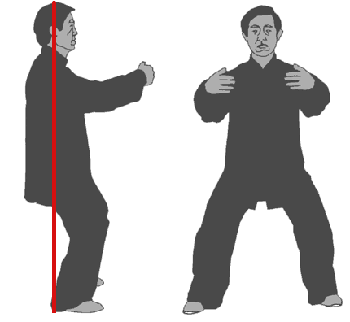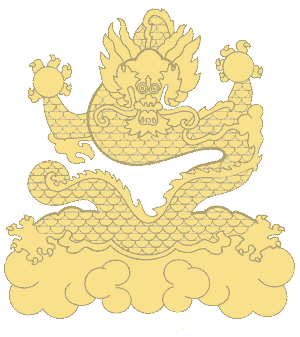The Practice of Zhuang Gong
Hun Yuan Zhuang:
1. Stand naturally, the hands loosely at the sides. The ears, shoulders,
hips, knees, and ankles should all be aligned when viewed from the
side.
2. Close the mouth, and place the tip of the tongue on the upper palate
behind the teeth. The eyes may be open or closed.
3. Fangsong (relax the mind and body). Mentally repeat the verse ‘weight
balanced, mind balanced, listen behind, qi balanced in the dantien”
4. Slowly bend the knees, lowering the center of gravity, and relax
the hips.
5. Shift weight to the right leg. Sink down, and lift the left heel,
followed by the toes. Step out to shoulder width, with weight still
on the right leg. Slowly shift weight back to the center of the body,
so it is evenly distributed on both legs.
6. Mentally repeat the verse “weight balanced, mind balanced,
listen behind, qi balanced in the dantien”
7. Beginning from the medulla and proceeding downward, relax each
vertebrae in the spine, counting to 9 for each vertebrae.
8. Slowly raise the arms to a shoulder height and width position,
as if holding a large ball. Depending on one’s fitness, the
arms may be held at a greater than shoulder width. As the arms rise,
simultaneously sink the hips more. Relax. Keeps wrists and fingers
loose and relaxed.
9. Mentally repeat the verse ‘weight balanced, mind balanced,
listen behind, qi balanced in the dantien”
10. Assume a posture with the chest concave, shoulders and hips relaxed,
the dantien area relaxed, the back straight. When all these requirements
are met, your body will feel comfortable.
11. Hold this position for a set period of time. Beginners should
work gradually to a time frame of at least 20 minutes.
12. Mentally repeat the verse ‘weight balanced, mind balanced,
listen behind, qi balanced in the dantien”
13. Very slowly lower hands to the sides, standing up as they drop,
but not completely. Keep the hips relaxed.
14. Allow the qi of the shoulders to flow downward to the hips: the
elbow qi to flow downward to the knees: and the qi of the hands to
flow downward to the feet.
15. Mentally repeat the verse ‘weight balanced, mind balanced,
listen behind, qi balanced in the dantien”. Relax any tense
areas in the body.
16. Slowly shift weight to the right leg. Lift heel and then toes
of the left foot, and move it inward next to the right foot. Place
first toes, then heels on the ground.
17. Mentally repeat the verse ‘weight balanced, mind balanced,
listen behind, qi balanced in the dantien”. Count silently to
9.
18. Stand up fully.
19. Relax and slowly open the eyes if they have been closed.
Notes on the Exercise
1. The alignment of the ears, shoulders, hips, knees and ankles insures
correct balance, and allows the muscles around the dantien (otherwise
engaged in keeping the trunk erect) to relax. When the area of the
dantien is relaxed, qi can return to it from the rest of the body.
The head should feel as if it is suspended from above, or that there
is a light object balancing on the bai hui point at the crown of the
skull. The chin is slightly tucked in. the bai hui should align vertically
with the hui yin point.
2. Weight is evenly distributed to both legs. Weight should be centered
on a point in front of the heel. The toes lightly grip the floor,
causing a “suction cup” like effect with the sole of the
foot.
5. ”Mind balanced”. Be calm and relaxed, half thinking,
half not thinking. Don’t dwell overmuch on any one thing.
6. “Listen behind”. Listen for sounds behind you. Combined
with the action of aligning the bai hui with the hui yin, this causes
qi to sink downward to the dantien.
“Qi balanced in the dantien” This refers to the opening
of the meridians and channels leading to and from the dantient. If
open, qi will flow from the various organs of the body to the dantien,
and the dantien qi will be full and strong. When the standing posture
is correct, the dantien becomes full, and the kidneys will feel warm.
The body will feel full of energy.
8. Holding the arms develops peng jin, promoting correct structure
for the propagation of power from the ground. The height and width
of the arms is dictated by the practitioners strength, as is the depth
of the stance. Movements should not be forced, but should be natural
and relaxed.
10. The following vertical alignments of the body should be present:
ears to shoulders, shoulders to hips, and hips to ankles.
11. After the correct posture has been assumed, and the body is relaxed,
the knees may be bent more to increase the exercise. Take care to
keep the kua closed, and the hips relaxed.However, do not let the
knees extend past the line of the toes.
When standing, qi should be felt in fingers, feet, and whole body.
This can be manifest a feeling of warmth, tingling, or slight numbness.
For the beginner, if discomfort is felt in the arms, it is permissible
to shake them out a bit. If the legs are uncomfortable, it is permissible
to rise slightly, but the hips may be kept relaxed. As progress is
made, the practitioner should endeavor to maintain as low as stance
as is possible in order to build strength in the legs and enhance
relaxation in the hips.
|



